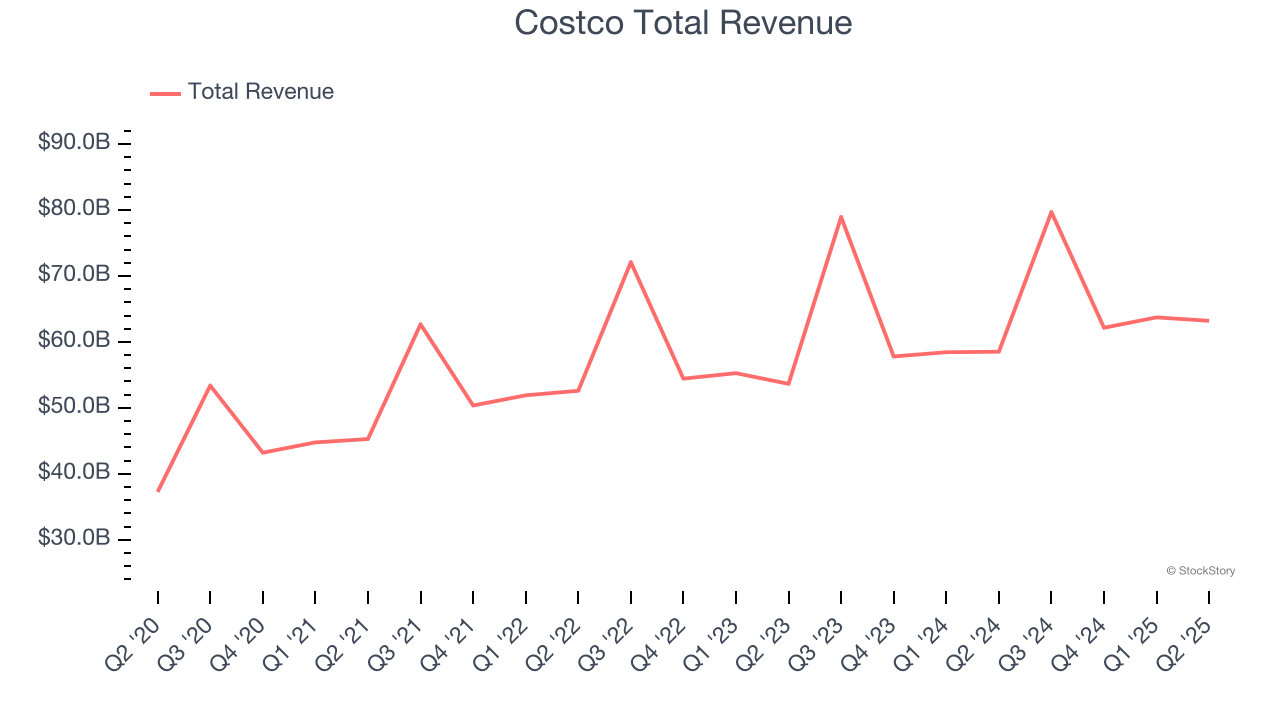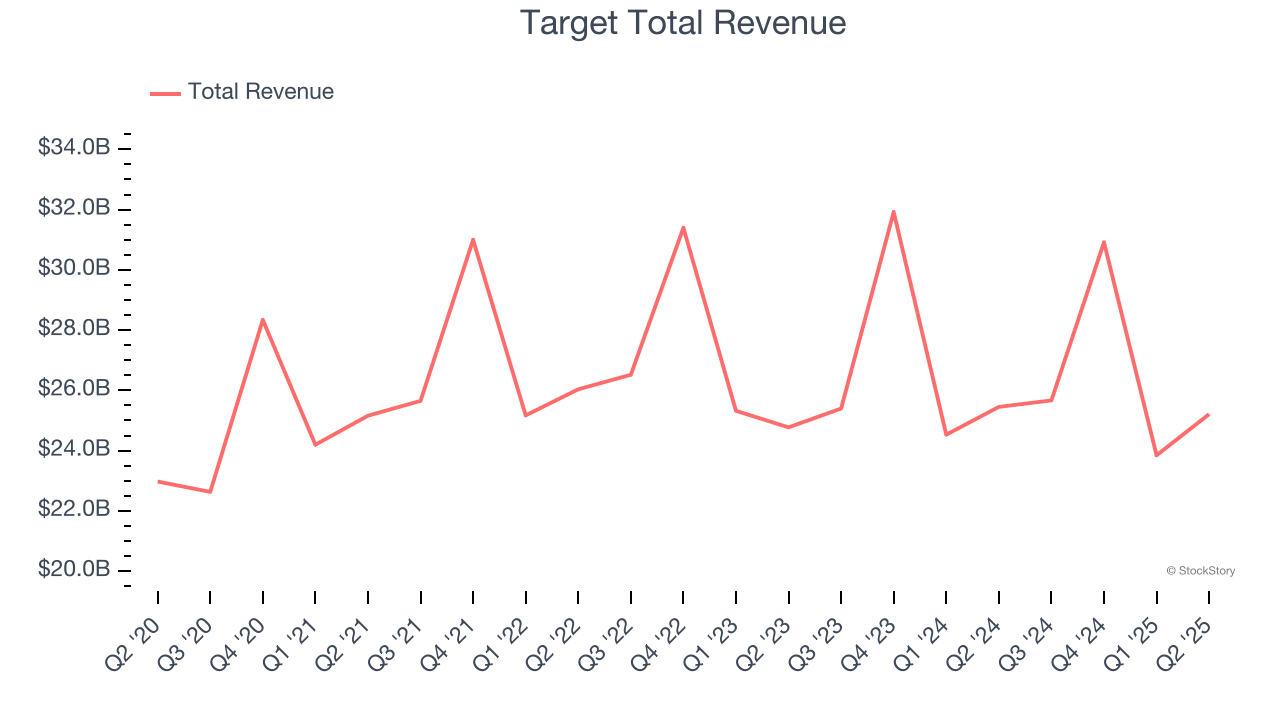
Wrapping up Q2 earnings, we look at the numbers and key takeaways for the large-format grocery & general merchandise retailer stocks, including Costco (NASDAQ:COST) and its peers.
Big-box retailers operate large stores that sell groceries and general merchandise at highly competitive prices. Because of their scale and resulting purchasing power, these big-box retailers–with annual sales in the tens to hundreds of billions of dollars–are able to get attractive volume discounts and sell at often the lowest prices. While e-commerce is a threat, these retailers have been able to weather the storm by either providing a unique in-store shopping experience or by reinvesting their hefty profits into omnichannel investments.
The 4 large-format grocery & general merchandise retailer stocks we track reported a mixed Q2. As a group, revenues along with next quarter’s revenue guidance were in line with analysts’ consensus estimates.
Amidst this news, share prices of the companies have had a rough stretch. On average, they are down 7.2% since the latest earnings results.
Best Q2: Costco (NASDAQ:COST)
Designed to be a one-stop shop for the suburban consumer, Costco (NASDAQ:COST) is a membership-only retail chain that sells groceries, apparel, toys, and household items, often in bulk quantities.
Costco reported revenues of $63.21 billion, up 8% year on year. This print was in line with analysts’ expectations, and overall, it was a satisfactory quarter for the company with a solid beat of analysts’ gross margin estimates.

Costco scored the fastest revenue growth of the whole group. Even though it had a relatively good quarter, the market seems discontent with the results. The stock is down 8.8% since reporting and currently trades at $942.44.
Is now the time to buy Costco? Access our full analysis of the earnings results here, it’s free.
Target (NYSE:TGT)
With a higher focus on style and aesthetics compared to other large general merchandise retailers, Target (NYSE:TGT) serves the suburban consumer who is looking for a wide range of products under one roof.
Target reported revenues of $25.21 billion, flat year on year, outperforming analysts’ expectations by 1.3%. The business performed better than its peers, but it was unfortunately a mixed quarter with full-year EPS guidance exceeding analysts’ expectations but a significant miss of analysts’ EBITDA estimates.

Target scored the biggest analyst estimates beat among its peers. Although it had a fine quarter compared its peers, the market seems unhappy with the results as the stock is down 8.8% since reporting. It currently trades at $96.15.
Is now the time to buy Target? Access our full analysis of the earnings results here, it’s free.
Weakest Q2: BJ's (NYSE:BJ)
Appealing to the budget-conscious individual shopping for a household, BJ’s Wholesale Club (NYSE:BJ) is a membership-only retail chain that sells groceries, appliances, electronics, and household items, often in bulk quantities.
BJ's reported revenues of $5.38 billion, up 3.4% year on year, falling short of analysts’ expectations by 1.9%. It was a slower quarter as it posted full-year EPS guidance slightly missing analysts’ expectations and a slight miss of analysts’ EBITDA estimates.
BJ's delivered the weakest performance against analyst estimates in the group. As expected, the stock is down 8.1% since the results and currently trades at $97.61.
Read our full analysis of BJ’s results here.
Walmart (NYSE:WMT)
Known for its large-format Supercenters, Walmart (NYSE:WMT) is a retail pioneer that serves a budget-conscious consumer who is looking for a wide range of products under one roof.
Walmart reported revenues of $177.4 billion, up 4.8% year on year. This result surpassed analysts’ expectations by 0.8%. However, it was a slower quarter as it produced a significant miss of analysts’ EBITDA estimates and full-year EPS guidance missing analysts’ expectations.
The stock is down 5.5% since reporting and currently trades at $96.87.
Read our full, actionable report on Walmart here, it’s free.
Market Update
As a result of the Fed’s rate hikes in 2022 and 2023, inflation has come down from frothy levels post-pandemic. The general rise in the price of goods and services is trending towards the Fed’s 2% goal as of late, which is good news. The higher rates that fought inflation also didn't slow economic activity enough to catalyze a recession. So far, soft landing. This, combined with recent rate cuts (half a percent in September 2024 and a quarter percent in November 2024) have led to strong stock market performance in 2024. The icing on the cake for 2024 returns was Donald Trump’s victory in the U.S. Presidential Election in early November, sending major indices to all-time highs in the week following the election. Still, debates around the health of the economy and the impact of potential tariffs and corporate tax cuts remain, leaving much uncertainty around 2025.
Want to invest in winners with rock-solid fundamentals? Check out our 9 Best Market-Beating Stocks and add them to your watchlist. These companies are poised for growth regardless of the political or macroeconomic climate.
StockStory is growing and hiring equity analyst and marketing roles. Are you a 0 to 1 builder passionate about the markets and AI? See the open roles here.
